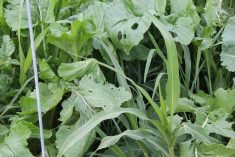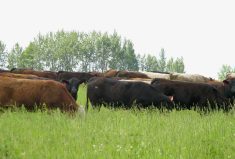It is a long, long way from Dallas, Texas to Hines Creek, Alta. But the distance did not deter Curt Hale’s grandfather and father from making the move to Alberta’s Peace Country.
The Hale family calls their operation Maverick Livestock, an apt name, with a maverick being an unorthodox or independent-minded person. The pioneering spirit is still evident today as the Hales were some of the first in the area, and province, to start growing cocktail/cover crops.
Looking for options
Curt Hale says that in 2013 they were looking for options to reduce their chemical usage and commercial fertilizer and at the same time improve soil health. He had been following some of the information coming out of the U.S., particularly from Ray Archuleta and Gabe Brown. When he found out about a cocktail/cover crop conference in Bismarck, North Dakota, he jumped in a plane and went to it.
Read Also

Why post-drought pasture management matters for beef farmers
Pasture management is always important, but it is especially important following a drought. During these challenging periods, pastures may suffer…
“That was one of the best things we ever did,” he says. “Then it was time for us to get home and get to work.”
Their main goal with the cocktail crops is feed production through silage for the mixed operation of 1,200 to 1,400 commercial cows. In 2014, they seeded their first cocktail crop.
“We picked a terrible year to try this, as it was extremely dry. But on the other hand, it was a good year for what we learned,” he says.
On the high ground, the yield was only 3.5 to five tons per acre. But in the low spots with more moisture they harvested 10 to 12 tons per acre. It was an easy decision to keep trying. As they continued on in the same fields, they could see an improvement in both yield and soil health.
“Every year got better and better,” says Hale.
They have experimented with different species and have settled on a mix per acre of 50 pounds of Morgan oats, 50 to 60 pounds of barley, eight to 10 pounds of hairy vetch, one to two pounds of sunflowers and 0.5 to one pound of some type of brassica such as Winfred kale or tillage radish. Sometimes they will also add 0.5 to one pound of phacelia for the pollinators. Seed costs run $35 to $45/acre. They have grown some of their own seed at times, lowering the seed costs to about $20/acre.
Hale stresses the variability in yield depending on the conditions. He says they average around eight tons/acre with a low of 4.5 tons and a high of 16 tons/acre. The rotation they follow is to grow cocktail crops for two years, then put in a cereal or pulse crop for one year and back to cocktails for two years.

The practice has allowed them to reduce input costs. “We could not believe we can get decent production without fertilizer but we have surpassed our expectations and production has continued to improve, as has soil health,” he says. “We have not bought chemical fertilizer, except for a grass seed production field, since 2014.”
“Since starting, another thing we have also noticed is an increase in sharp-tail grouse,” says Hale. There has also been an increase in pollinators. A neighbouring beekeeper who puts hives on their land had the highest yield in both honey production and quality this year.
Hale gives credit to their local forage association, the Peace Country Beef and Forage Association.
“They do a tremendous job at the research farm at Fairview and have been a major asset to us and our area with a wealth of information on varieties and mixes,” he says. “I can’t say enough about how great a resource they are.”
Supporting the cow herd
“We calve on grass in May,” Hale says. Calves are overwintered and backgrounded and usually sell at the end of January, beginning of February. They are selling the calves right off the cow. The winter feeding of the cocktail crop silage includes creep panels and separate feed bunks allowing the calves access to feed without their mothers.
“But they are still able to nurse their mothers when they want,” says Hale.
The energy and protein in the cocktail ration helps support this approach.
“We have less health issues and less stress,” he adds. Some of the cocktail crops are swathed and grazed in the fall.
The cow herd is predominantly Black Angus and Black Simmental. They run a small herd of 20 purebred cows from which they raise most of their own bulls. Fifteen per cent of the cow herd is culled each year and they usually keep 300 heifers for the herd.
Calves are typically marketed through TEAM. “At that time of year, we can be selling both into the grass market or the heavier calves can go right to the feedlot,” says Hale.
“One of our goals is to leave the land in better shape than when we started, for the next generation,” he adds. And they are working on the next generation with their two sons involved and now some of the grandkids.
The operation is certainly a long way from where the Hales started, but the philosophy holds true at Hines Creek as much as it did in Texas.
Curt Hale’s cocktail crop checklist
- Don’t seed the whole farm down the first year. Try it on a smaller scale but give it two to three years to test. It takes degraded soil some time to improve.
- Moisture is key but as time goes
on you will get more and more production with less rain by keeping the ground covered and getting more biodiversity in the soil. - Be careful of your mixes and don’t try anything and everything.
- Know what your goals are as far as production and soil health.
- Be cautious of nitrates after the first frost.
- Network and learn. Research and go to conferences and don’t be afraid to ask questions.
- Don’t be afraid to experiment on a smaller scale with different mixes. Your farm is the best test plot.
















